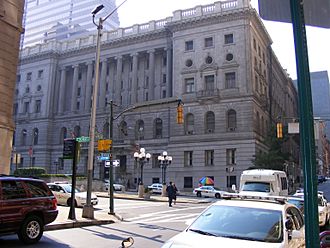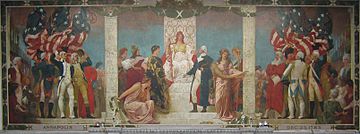Baltimore City Circuit Courthouses facts for kids
Quick facts for kids Clarence M. Mitchell Jr. Courthouse |
|
|---|---|
 |
|
| General information | |
| Architectural style | Greek Revival |
| Location | Downtown |
| Town or city | Baltimore City |
| Country | United States of America |
| Coordinates | 39°17′27″N 76°36′47″W / 39.2907°N 76.613°W |
| Construction started | 1896 |
| Completed | 1900 |
| Cost | $2.25 million |
| Client | Mayor and City Council of Baltimore |
| Technical details | |
| Size | 6 floors |
| Design and construction | |
| Architect | Wyatt and Nolting |
The Baltimore City Circuit Courthouses are important state buildings in downtown Baltimore, Maryland. They are where many legal cases for the state of Maryland happen. These two main courthouses, the Clarence M. Mitchell Jr. Courthouse and Courthouse East, stand across from each other on North Calvert Street. They are near the Battle Monument, a famous landmark.
Baltimore's first courthouse was built in 1767. It was also used by the new United States federal courts for a short time. On July 28, 1776, the Declaration of Independence was publicly read here. This was just after it was approved by the Second Continental Congress in Philadelphia. The first courthouse was taken down around 1800.
A second courthouse was finished in 1805. It was built west of the old Courthouse Square, which later became Battle Monument Square. This square honors those who fought in the Battle of Baltimore during the War of 1812. This second courthouse was partly burned in 1835 during a time of unrest, but it was quickly fixed. It was torn down around 1896.
The third and current main courthouse was built between 1896 and 1900. It covers an entire city block. This is the building now known as the Clarence M. Mitchell Jr. Courthouse.
A smaller federal courthouse and Post Office was built in 1860. It was replaced in 1889 by a much larger building. This larger building was then replaced in 1932 by the structure now called Courthouse East. In 1977, the federal government gave this building to the city.
Today, the Clarence M. Mitchell Jr. Courthouse and Courthouse East are the main buildings for Maryland's state court system in Baltimore.
Contents
What Happens Inside the Courthouses?
These two courthouses are home to 30 judges for the 8th Judicial Circuit of Maryland. They handle many different types of cases, including:
- Criminal cases
- Civil cases (disputes between people or groups)
- Family cases (like those about families and children)
The buildings also house other important offices. These include the State's Attorney for Baltimore City, the Clerk of the Circuit Court, and the City Sheriff's Office. There's even a museum, the Baltimore Courthouse and Law Museum.
History of the Area
The area where the courthouses stand has a long history. The first federal courthouse in the city was built where Battle Monument Square is now. The Battle Monument itself was started in 1815. It honors those who fought in the War of 1812. When it was finished in 1827, President John Quincy Adams called Baltimore "The Monumental City."
Clarence M. Mitchell Jr. Courthouse
In 1894, many architects from across the country entered a contest to design the new federal courthouse in Baltimore. The winning design was a beautiful Beaux Arts style building. It was designed by a Baltimore firm called Wyatt and Nolting. The first stone for the building was laid in 1896, and it was officially opened on January 8, 1900.
Inside the courthouse, artists added amazing murals between 1902 and 1910. One famous mural, painted by Edwin Blashfield in 1903, shows General George Washington's resignation as commander-in-chief of the Continental Army. Outside, a bronze statue of Cecilius Calvert, 2nd Baron Baltimore, the founder of Maryland, was put up in 1908.
Over the years, the courthouse has been updated. In 1950, it was expanded and renovated to meet modern needs. In 1985, the building was renamed in honor of Clarence M. Mitchell Jr.. He was a famous civil rights leader from Baltimore. More renovations happened around 2000 to improve the building's outside. Experts suggested that the building should be kept and updated, not torn down.
What Does the Courthouse Look Like?
The Clarence M. Mitchell Jr. Courthouse takes up an entire city block. It has eight huge Ionic columns on the side facing Calvert Street. Each column weighs 35 tons and is 31 feet tall! These columns are even taller than those at the United States Capitol. The lower part of the building is made of granite from Woodstock, Maryland. The rest of the six-story building is covered in white marble.
Courthouse East (Old United States Courthouse and General Post Office for Baltimore)
|
U.S. Post Office and Courthouse
|
|

Courthouse East, Baltimore, Maryland
|
|
| Location | 111 N. Calvert St., Baltimore, Maryland |
|---|---|
| Area | 1.3 acres (0.53 ha) |
| Built | 1930 |
| Architect | Whetmore, James A.; Et al. |
| Architectural style | Classical Revival |
| NRHP reference No. | 77001530 |
| Added to NRHP | March 25, 1977 |
Courthouse East is a historic building that used to be a combined post office and federal courthouse. It is located in Baltimore, Maryland. This building also covers a whole city block. It was finished in 1932, at the start of the Great Depression. Building it helped create thousands of jobs in the city. The outside of Courthouse East is made of white Indiana limestone and has some classical decorations.
In 1975, the federal government gave this courthouse to the state of Maryland. This happened after the federal courts moved to a new building. The main U.S. Post Office for the city also moved to a new location in 1972. The state finished renovating Courthouse East by 1990.
Important Cases at Courthouse East
Some important federal court cases happened in this building, including:
- 1934: A judge here was the first to rule against a new law from Congress.
- 1968 and 1969: People protested the Vietnam War here.
- 1973: A Vice President resigned after issues with his taxes.
After it became a state court building, a Baltimore mayor had a court case here in 2010.
The U.S. Post Office and Courthouse was added to the National Register of Historic Places in 1977.





